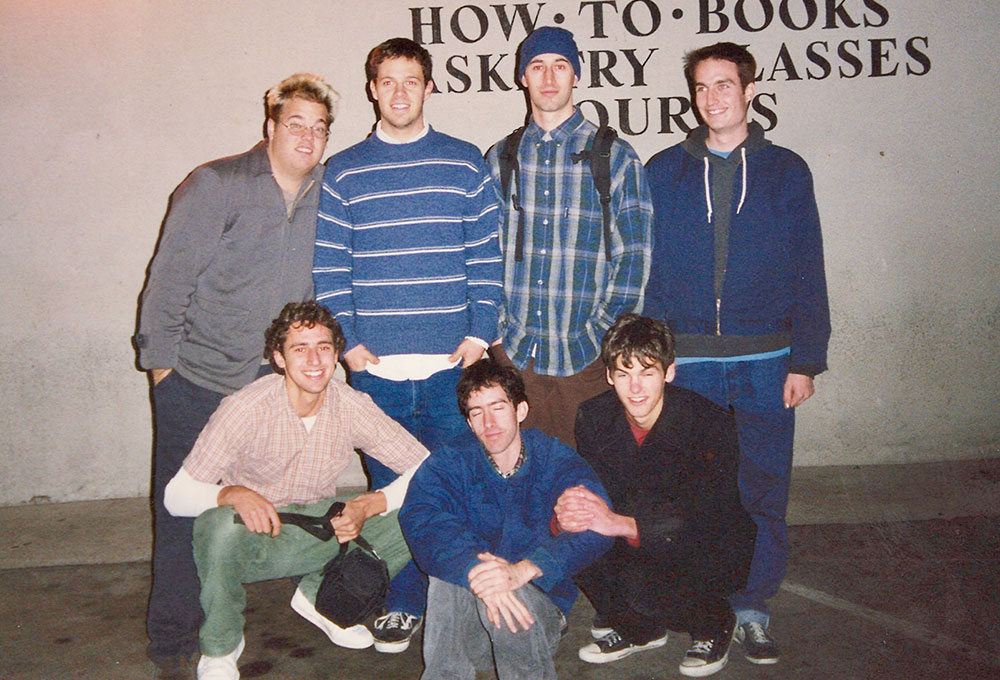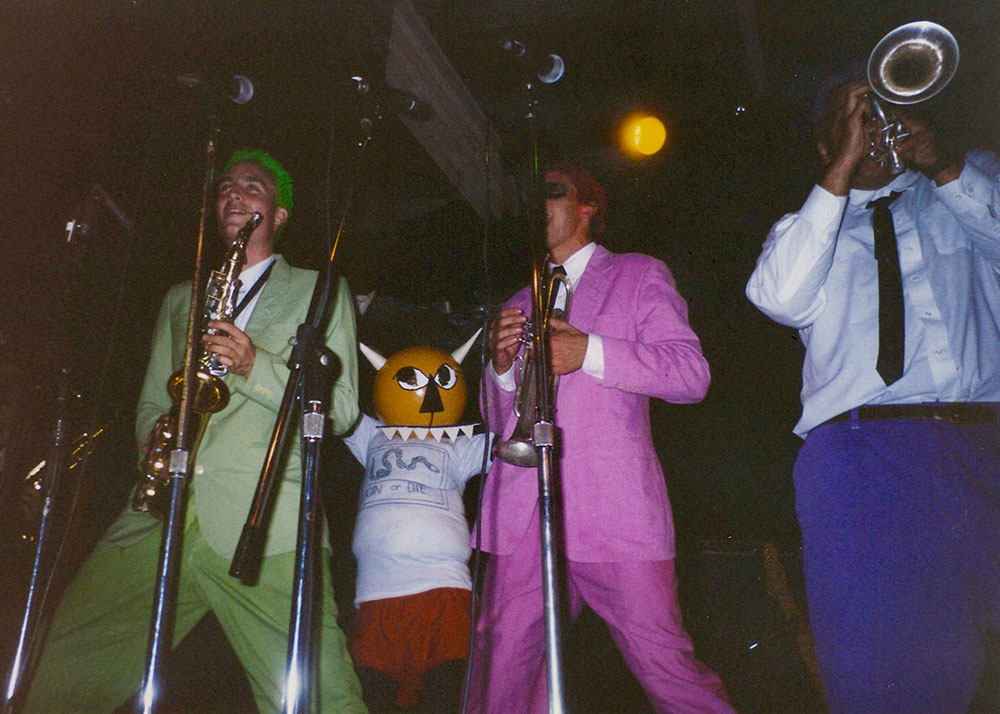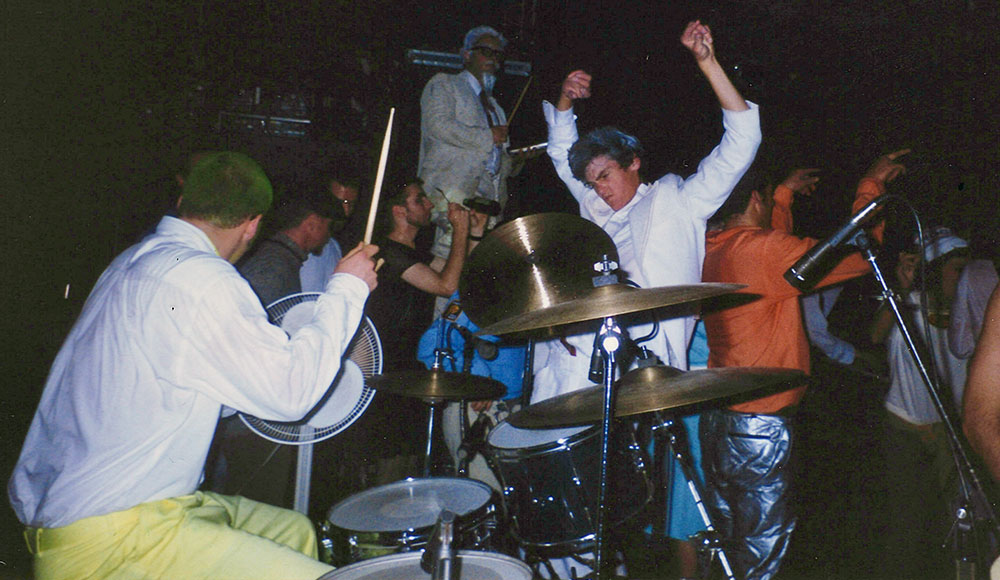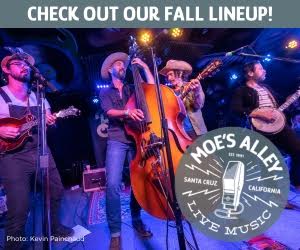Asian Man Records, the South Bay DIY record label that is turning 30 next year, is run by Mike Park, a former member of Skankin’ Pickle. Using material from more than a hundred hours of interviews, author Mike Huguenor chronicles its history in Elvis Is Dead, I’m Still Alive, which will be published May 19, 2026 by Clash Books. Below is an excerpt about the Santa Cruz band Slow Gherkin, formerly on the label. Preorders for Elvis Is Dead can be placed at clashbooks.com.
Out in Santa Cruz, CA, the 10-person Slow Gherkin used to roll together as a unit, all piling into the orange 1979 Dodge van they dubbed “the Creamsicle.”
“It was like a clown car,” says [Asian Man Records label manager] Miya Osaki, recalling the endless flood of boys that spilled out each time the Creamsicle parked anywhere. There was James Rickman and AJ Marquez, guitarists and frontmen of the band, Zack Kent and Zach Oliver, the rhythm section, keyboardist Peter Cowan, plus their sizable horn section, which included at one time or another Phil Boutelle, Josh Montgomery, Rob Pratt, Matt Porter, Achilles Poloynis, Ross Peard, Nick Bianchini, and Eric Johnson.
Slow Gherkin were directly influenced by Skankin’ Pickle. It was almost like a teen movie, how Pickle had entered their lives. It started one summer afternoon, when they all hopped a neighbor’s fence.
Marquez and Rickman had known each other since preschool and spent most summers together since. Each had a parent who worked for Shakespeare Santa Cruz. During the hot summer months, they’d run around the empty theaters together while the adults prepared productions, occasionally scoring a role as a page or one of Shakespeare’s rare child characters.
Since sixth grade, they and their cohort of friends had been spinning out creative projects of their own. They started by recording fake radio programs on their friend’s boombox, trying out DJ voices and writing skits from the bedroom floor. Then, when they all began picking up instruments, they collectively packed their equipment and moved it into the garage at that same friend’s house, the house they were headed to the afternoon when they hopped the fence.
“He had a pool and his parents were very down with feeding us as long as we kept the woodbox full, changed the dirt, whatever odd jobs we could do around the place,” says AJ Marquez. “We would go there every day, swim and be chased around by his dogs, play music, and pretty much be fed by his parents.”
On their way to their daily free food and poolside hang, the crew stopped when they heard the unmistakable sound of live rock music wafting out of a neighborhood house. Frantic, funky guitar shifted to a chunky fuzz as the band kicked into a big chorus. Somebody was covering Living Colour’s “Which Way to America?”
“We were like, ‘What is that rock and roll music? That’s badass,’” recalls Marquez.
On that particular day there were five of them: Marquez and Rickman, plus Porter, Montgomery and their friend Julian. The squad of teens followed the music to a fenced backyard and commenced to peer through a gap in the slats. Then, when they could wait no longer, they hopped over.
The sudden appearance of a large group of teens in the backyard was a little too hard for the neighborhood band to ignore. They cut the song short and addressed their audience, inviting them inside to watch them finish practice. It was their last one, they said, before a show in town at the Loudon Nelson Center. Would their new fans like to come?
That night, most of the crew experienced their first real rock show. It was August 16, 1991, and they were on the verge of entering high school.
Hard Up, the neighborhood band they had stumbled upon, took the stage first, performing their cover of Living Colour’s “Which Way to America?” partway through the set. Marquez and the crew cheered their new friends from the crowd.
Two more openers followed Hard Up. Then came the headliners, a group of punks from over the hill that the Santa Cruz Sentinel had dubbed “the South Bay bad boys.” Skankin’ Pickle. As the band careened across the stage, Marquez could feel his eyes dilating.
“It was just like, what even is this? This is so insane. Little teenage brains exploding, spazzing out. Getting just destroyed in the pit and having people jump on our head. It was that vibe of raw energy and love and people caring for each other, people just picking you up. And also spazziness, full spazziness,” Marquez says.
James Rickman wasn’t able to make the show that night. A self-professed “total drama dork,” he was busy illustrating the transience of life on Earth as Wally Webb in Shakespeare Santa Cruz’s production of Our Town. When the denouement had concluded and curtain calls were made, Rickman linked back up with his crew. He found them dazed from the show, excitedly talking about the band they had just seen. Reunited, they did what teens do best. They took to wandering the streets.
Halfway up the hill to UCSC the group was on a quiet residential street when they heard a vehicle approaching. A van pulled up beside them, then came screeching to a halt. The door slid open. Inside, was Skankin’ Pickle. Once again, Marquez’s eyes widened.
“I mean, like dreams come true, Skankin’ Pickle are like, ‘Hey, do you guys know where this band lives?’” he remembers.
The band they were looking for was Hard Up. The teens stood on the empty street in disbelief. Finally, Marquez says, someone spoke.
“We were like, ‘Oh! Oh yeah! We do! We totally do!’”

***
That night, the crew all ended up at the party at Hard Up’s house. Thirteen years old and awestruck, they mostly clung to the wall, mouths twisted into nervous smiles as they felt both impossibly cool for being in the room with rockers fresh from the stage, and also far and away the least cool people in the room.
By that time, the young crew of Santa Cruzans had already worked their way through a small slew of their own bands. There had been In Session, named after Rickman’s father’s college band, then the profoundly harmless sounding This Side Up, a band that Marquez describes as “really logo-centric.”
“I remember drawing a pretty badass cardboard box logo with some U arrows,” he says with a chuckle.
From there, the group tried some eerie theatricality with the name the Dead Jesters, before morphing into a metal-inspired band called Inner Sanctum. At that point, Marquez was dropped, replaced by Matt Porter, whose shredding chops fit the band’s new sound. But as the crew became aware of Skankin’ Pickle—and, from there, Fishbone, Bad Manners, and the wider ska scene—it became clear that their destiny lay in upbeats. There were already plenty of horn players in the crew (one of whom was Matt Porter). So, Marquez was back in.
It was then 1993. In their earliest form, Slow Gherkin was a four-piece, with frontman James Rickman on drums, Marquez on guitar, Zack Kent on bass and Phil Boutelle on sax. They spent almost two years this way, first sketching out goofy, teenage takes on ska music, and then penning some of their first serious songs as a band.
Gherkin have always maintained that any similarities between their name and Skankin’ Pickle’s were either coincidental, cosmic or subconscious. Either way, it wasn’t exactly intentional. In 1999, Rickman told Florida zine Ink 19 (“The glass bottom boat of the cultural press”) that Pickle were “our first big influence. I mean, they were it for a long time, so sure, it’s a cosmic thing, really.”
The actual story behind the name is more specific than that. Like Skankin’ Pickle’s own name (and MU330’s), it went back to the band members’ school days.
One day in high school, James Rickman went to grab a book from his locker when he found that it had been vandalized. Where previously there had been nothing, now, pasted to the locker’s vented metal exterior was a sticker of a frog, speech bubble rising from his head, asking, “Do you want to do the slow gerkin with me?”
There was no explanation, and the word “Gherkin” was spelled wrong.
“It was g-e-r-k-i-n,” says Rickman. “But something about that sticker, just a Kinko’s black and white sticker, I thought, whatever that is, I want in.”
He soon found that the artist behind the sticker was the bassist in the school band, Zack Kent, who he describes as a “mysterious guy.” In actuality, he was just a little older. …

***
Slow Gherkin took after Skankin’ Pickle in a few other ways, as well. Like Pickle, they kept the energy high at live shows, their sizable band creating a huge sound as Rickman strutted across the audience’s shoulders or writhed amongst mic cables on the ground.
And like Pickle, they had formed their own label, Join or Die, which released cassettes of their own bands like Inner Sanctum and the short-lived Cold Cuts. It also released a small original run of the first Slow Gherkin album, Double Happiness.
In between Join or Die and Asian Man, there was also Raj Records, a label run by the Davis-based ska band Punch the Clown. Raj had been the first label to express interest in Gherkin. Before it was re-released by Asian Man, Double Happiness was released in small CD runs by both Join or Die and Raj Records. …
Having gone from young fans of Skankin’ Pickle to friends of Mike Park, Gherkin were one of the few bands to successfully ask themselves onto Asian Man.
To impress their prospective label, they drew up a business plan, complete with tour routes and promotional avenues. Then they offered to take Park out to dinner.
At his house before dinner, they filled conversation with vague statements about their commitment to music, how much they had been practicing and how serious they were. Finally, when they had surrounded him around the dinner table, they popped the question: would he release their band?
Marquez still remembers his answer, delivered with the kind of characteristic off-handedness:
“Sure. Totally.” …
Ultimately, though, Slow Gherkin weren’t looking to find a label to re-release their debut. They wanted a home for their next record, their first real full length as a band. One of the best albums Asian Man ever released: Shed Some Skin.
***
Some of ska’s misfits were misfits for aesthetic reasons, ramped-up wackiness or unexpected, near unbearable intensity. In the case of Slow Gherkin, they were misfits largely due to timing.
Asian Man released Shed Some Skin (AM-035) in 1998, one release after Alkaline Trio’s debut LP Goddamnit. By then, Dan Andriano was on his second post-Slapstick band, Limp Bizkit had already landed on radio and MTV, and ska music had begun to seem to be like something from before. …
Unfortunately, Gherkin were slow to get its best self on record. It was already 1997 by the time they took to Campbell’s SoundTek to record Shed Some Skin. By then, in Park’s opinion, the third wave had begun to crest. The band was spending two weeks in a pricey studio. He couldn’t help but worry.
One day, towards the end of recording, Marquez was trying to get his backups for “Trapped Like Rats in Myers Flat” recorded. As he was struggling to nail the part, Park rolled in, fresh from the day’s basketball session at the YMCA.
“He popped by the studio, stoked to see us, and we’re obviously stuck. And I think his brain just broke,” Marquez remembers. “He was just kind of bouncing the ball going, ‘What am I doing? Oh my god. Ska is dead. This album is gonna go nowhere.’ That was his pump-up speech for me as I was trying to get this vocal track: ‘Oh no, this is a terrible time, this record’s not going to sell. OK, see you guys later. Good luck!”
“In my memory, that was multiple days,” Rickman says, confirming Marquez’s story. “He would stop by a lot at Soundtek and just kind of pace around the control room going, ‘Oh man, no one’s going to buy this album, it’s all over, what am I doing, oh my god.”
Though it arrived towards its end, Shed Some Skin was one of the strongest records of ska’s third wave. Driven by tight musicianship, two very distinct vocalists and some creative pop songwriting, it is an album that blossoms with repeat listens. Lyrics reflected the band’s emerging maturity, describing the kinds of situations most young adults face while struggling to find their footing, all the wrong turns, late-night parties, tested friendships and painful losses of innocence. …
With their first real album out on a real record label, the band piled back into the Creamsicle and hit the road.
Things did not get off to a smooth start.
Related: Don’t miss Brad Kava’s conversation with Bill Kopp about his new book exploring 30 overlooked and wildly inventive concept albums.












